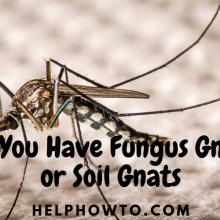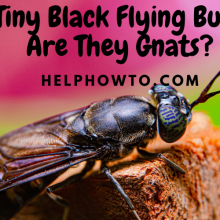Gnat vs Fruit Fly – What is The Difference? | HelpHowTo
Summary of Gnat vs Fruit Fly
Though tiny, gnats and fruit flies differ as pests – gnats have elongated bodies and swarm outdoors, attracted to moisture, while fruit flies hover in kitchens drawn to decay. Still their similarities pose identification challenges, wasting pest control efforts if inaccurate. Both transmit diseases and impact agriculture, but vinegar flies only live 2 weeks versus gnats’ season-long stays. While temporary insecticide fixes are tempting, sanitizing breeding grounds like drains or plants proves more effective to control future generations.
Traps with tailored lures specifically catch gnats or fruit flies. If issues continue despite best sanitation, trap, spray efforts, recognizing when populations constitute severe infestations warranting professional mitigation is key. As rapid reproducers, monitoring, properly identifying, and responding appropriately to either flying pest saves time, money, and sanity. Misdiagnosis risks ineffectiveness, but understanding subtleties between gnats and fruit flies allows tailored targeting to manage both appropriately.

Our Top 5 Recommended Indoor Genat Traps
Sick of pesky gnats invading your home? Discover the top 5 indoor gnat traps to banish these annoying insects for good! Our expert reviews reveal the most effective, easy-to-use traps. From powerful UV attractants to eco-friendly vinegar traps, we’ve thoroughly tested and ranked the best solutions. Check Now

Comparing Between Gnats and Fruit Flies
Swarming pests driving you bananas? It could be tiny gnats or fruit flies that seem one and the same. But understanding key distinctions in their appearance, behaviors, risks, and control methods is no small matter.
At just 1/8th inch long, both gnats and fruit flies appear as specks to the naked eye. Similar size and shared affinity for moisture and decay makes differentiating between them challenging. Yet they belong to entirely different insect families with preferences that impact where each thrives and how to tackle infestations.
Appearance, Developmental Stages, and Behavioral Differences
Gnats encompass mosquitoes, black flies, midges, and crane flies that all have variations of elongated bodies, wings, and leg proportions. Vinegar or pomace fruit flies have characteristic red eyes, yellow-brown fused thorax and abdomen, and patterned wings.
Fruit fly larvae are legless, creamy white in color, and dwell within fermenting fruits, vegetables and liquids. Gnat larvae depend on species but generally appear translucent, darker in tone, and reside in moist soils or aquatic environments.
Gnats erratically swarm near faces, drawn by carbon dioxide, heat, and scent signals. Vinegar flies hover in kitchen zones, their nervous systems detecting airborne yeasts and alcohol from decay. Both pests are attracted to light but fruit flies only live about two weeks while gnats persist for multiple seasons.
Preferred Environments, Food Sources & Reproduction Habits
Gnats seek damp soils, marshes, and shaded areas outdoors as prime real estate. But certain fungus gnat species follow potted plant roots indoors. Female gnats require an extra blood meal to lay 150-200 eggs. Larvae feed on fungi before developing into flying ad
ults within 3-4 weeks.
Meanwhile, fruit flies prefer the dark, humid confines of kitchen drains, pipes, trash bins and bottles where fermented produce or beverages accumulate. Maggots hatch from eggs laid directly within moist organic matter, growing for 5-7 days before morphing into reproductive adults in 8-10 days.
Pest Problems: Bites, Disease Transmission & Agricultural Damage
Primarily a nuisance issue, some gnats transmit livestock or plant diseases and female mosquito varieties draw blood using serrated mouth parts. Annoying swarms peak during summer. Farmers also grapple with midges and gall gnats destroying cereal, corn and rice yields.
Vinegar flies don’t bite but filthy feet and appetite for decay make them ideal disease vectors. Studies link fruit fly presence to E.coli, salmonella and shigella outbreak risks. Contaminated kitchens require rigorous sanitation before eateries can reopen after closures. Their rapid lifecycle also inflicts agricultural losses.
Prevention and Treatment Tactics
While insecticides provide temporary relief, addressing root causes is key to blocking future generations. Drain or fill in marshy mosquito breeding grounds. For midges, create buffer zones from agricultural settings using physical barriers and fans. Maintain cleanliness indoors and out with proper waste disposal and by clearing clutter to discourage infestations taking hold. Strategically deploy pheromone or yeast-based traps suited to either gnats or fruit flies. Sticky ribbons hung near potential indoor breeding sites also deter flies while aerosol sprays offer direct knockdown. Seek expert guidance tailored to the species identified if issues persist despite best efforts.
In Closing
Living with two alike yet distinct insect annoyances multiplies the challenge. Ensure proper identification between gnats vs. flies by scrutinizing subtle physical and behavioral cues. Tailor control methods to environmental factors unique to each while reducing overall pest conduciveness. With persistence combining sanitation, traps, insecticides and habitat modifications, it is possible to manage both flying pests. But severe repeated infestations signal bigger underlying issues requiring mitigation guidance from pest management professionals.
The main downside is that without diligent monitoring and intervention, both gnats and fruit flies can quickly spiral out of control since they reproduce rapidly. Their similarities also make misidentification easy, leading to wasted efforts. Persistent large-scale infestations causing significant agricultural or food safety issues should be handed over to experts. Please let me know if you would like me to modify or expand this comparison in any way!

Our Top 5 Recommended Indoor Genat Traps
Sick of pesky gnats invading your home? Discover the top 5 indoor gnat traps to banish these annoying insects for good! Our expert reviews reveal the most effective, easy-to-use traps. From powerful UV attractants to eco-friendly vinegar traps, we’ve thoroughly tested and ranked the best solutions. Check Now
FAQs and Answers
What are the different types of gnats and fruit flies?
There are many different types of gnats and fruit flies that may be encountered:
Types of Gnats:
- Fungus gnats – These small black gnats are attracted to moist soil and decaying plant matter. They are common in potted plants and greenhouses.
- Gall gnats – These gnats feed on plants, creating root galls or other plant deformations. Some species are major agricultural pests.
- Black flies – Also known as buffalo gnats, these biting flies are found near rivers and streams. The females need blood to produce eggs.
- Sand flies – Found in tropical and subtropical areas, these gnats can transmit leishmaniasis and other diseases through their bites.
- Midges – These tiny flies are often seen swarming at dusk in large mating groups. Some species bite mammals to obtain blood meals.
Types of Fruit Flies:
- Vinegar or pomace flies – Red-eyed flies attracted to fermenting fruits and vegetables. The most common fruit fly found in homes.
- Drosophila melanogaster – Small, yellowish flies used extensively in genetic research and biology laboratory studies.
- Spotted wing drosophila – An invasive agricultural pest, the females of this species have serrated ovipositors to attack ripening fruit crops.
- Mediterranean fruit fly – Considered one of the world’s most destructive pests, these flies damage fruits through larval feeding tunnels. More prevalent in tropical climates.
- Quezada fruit flies – Recently discovered species of fruit flies that inhabit desert regions and have specialized adaptations to dry conditions.
There are many more niche gnat and fruit fly species, but these examples represent some of the most common groups and their distinguishing features.
How do I know if I have gnats or fruit flies?
Here are some key differences to help determine if you have gnats or fruit flies:
Appearance:
- Gnats have thin, elongated bodies and look more mosquito-like. Fruit flies have stockier, oval bodies.
- Fruit flies often have bright red eyes. Gnats tend to have darker, less prominent eyes.
- Gnats have longer wings that tent over their body at rest. Fruit fly wings are shorter and more triangular.
Behavior:
- Fruit flies gather near fermenting foods like vinegar or rotting produce. Gnats swarm randomly without an attractant.
- Gnats dart around rapidly, changing directions. Fruit flies have slower, hovering flight patterns.
Breeding Sites:
- Gnats lay eggs near moisture in soil, plants, outdoor water sources. Fruit fly eggs are laid directly on wet decaying organic matter.
Traps:
- Vinegar and wine traps attract lots of fruit flies but few gnats.
- Fungus gnat sticky traps draw in mostly gnats around potted plants.
Larvae:
- Gnat larvae found in soil, aquatic habitats, or roots of plants. Fruit fly larvae found in rotting produce.
Getting a close look and noting differences in body, wings, flight behavior, breeding sites, trap results, and larvae locations are the best ways to definitively diagnose if you have a gnat or fruit fly issue.
Do gnats and fruit flies come from the same place?
No, gnats and fruit flies do not come from the same place. They have very different origins and preferred breeding environments:
Gnats:
- Come from outdoors near standing water sources, moist soil, decaying organic matter, or plants
- Female gnats lay eggs in vegetation, potting soil, surface debris, wetlands, etc.
- When eggs hatch, gnat larvae continue developing in damp soils, aquatic sediments, or within plant roots and leaves
Fruit Flies:
- Emerge from soggy, fermenting fruits, vegetables, and other wet organic materials inside homes/buildings
- Adult female fruit flies lay eggs directly on surfaces of ripening produce, rotting potatoes, soggy mop closets, dirty drains, etc.
- Larvae hatch right on wet decaying matter and feed in the film of moisture and microbes coating these items
While both gnats and fruit flies need moisture and organic matter to breed, gnats do not originate from indoor kitchen composts, leaks, etc. like fruit flies. And fruit flies come from immediate areas of wet rot, not from outdoor water sources harboring gnats. Knowing these developmental origin differences is key to targeting breeding sites for control.
So in summary, gnats and fruit flies come from very different environmental breeding grounds and should be managed through tailored tactics suited to their unique places of origin.
Will the same traps and treatments work on both gnats and fruit flies?
No, you typically need different traps and treatments for effectively controlling gnats versus fruit flies due to differences in their biology:
Traps:
- Fruit fly traps containing vinegar, wine, yeast, etc. will attract many fruit flies but few if any gnats.
- Traps with features like yellow sticky cards and pheromone lures work well for capturing fungus gnats but have little effect on fruit flies.
Treatments:
- Applying bacterial sprays containing Bti or Mosquito Dunks to breeding grounds in soil or drains will kill gnat larvae but not impact fruit flies.
- Insect growth regulator products often deter fungus gnats but show minimal efficacy against fruit flies.
Reasons:
- Gnats and flies have preferences for different food sources used in traps as bait.
- Larval habitat differences mean breeding site applications must be tailored.
- Certain active ingredients only interrupt growth cycles of specific insect species.
While both require an integrated pest management plan, the most effective control regime for gnats contains different traps and targeted treatments than fruit fly management since their life cycles and needs do not overlap much. An approach blended for each is needed to mitigate the unique pest.
So in summary – no, the same solutions will not work well for both gnats and fruit flies in most cases. Customizing tactics is key.
When should I call for professional help with gnats or fruit flies?
It’s advised to call a professional pest control expert for help with gnats or fruit flies in the following situations:
- Infestations Persist Despite Efforts: If you’ve thoroughly cleaned and used recommended DIY traps/treatments, but still battle swarms of gnats or fruit flies after 2-3 weeks, it’s best to seek pro guidance.
- Severe Infestations: When dealing with substantial indoor swarms of 100+ gnats/flies daily or dense seasonal outdoor clouds, bringing in an expert right away can help tackle the root sources faster before populations explode more.
- Identifying Unknown Species: If unable to diagnose what specific gnat/fly species (fungus, phorid, etc.) is causing the issue, an inspection could pinpoint the species to customize an effective plan.
- Sensitive Areas: Professional treatment is best for commercial kitchens, nursing homes, hospitals, etc. where sanitation standards are rigorous to prevent foodborne Illnesses or transmission risks associated with pests.
- Rental Homes/Businesses: If not the property owner, contacting the landlord immediately at the first signs of infestations allows them to arrange professional mitigation to prevent worsening issues.
Getting pro help quicker when facing severe infestations of unidentified culprits, sensitive accounts, rental units or persisting struggles despite your best solo effort is advised. Expert guidance tailoring plans to the pest’s specifics can resolve problems faster.

Our Top 5 Recommended Indoor Genat Traps
Sick of pesky gnats invading your home? Discover the top 5 indoor gnat traps to banish these annoying insects for good! Our expert reviews reveal the most effective, easy-to-use traps. From powerful UV attractants to eco-friendly vinegar traps, we’ve thoroughly tested and ranked the best solutions. Check Now




